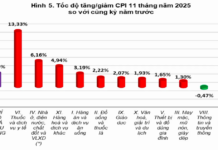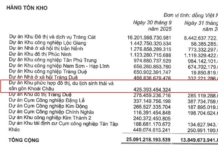According to the “Global Warehouse Industry Study 2023” recently released by Zebra Technologies on March 13, 2023, 58% of warehouse managers plan to implement radio frequency identification (RFID) technology by 2028, increasing the visibility of stored goods and reducing out-of-stock situations.
73% of decision-makers globally have already or are planning to accelerate their modernization projects, with the figure reaching 69% in the Asia-Pacific region (APAC). As many as 88% of managers in APAC are expected to use technology to increase supply chain visibility in the next five years.
VIETNAM’S WAREHOUSE INDUSTRY TO GROW 11% IN THE 2024-2032 PERIOD
Digital transformation is booming in various industries including retail, warehousing, manufacturing, with logistics playing a vital role in Vietnam’s supply chain.
Mr. Christanto Suryadarma, Vice President of Sales for Southeast Asia (SEA), South Korea, and APJeC Channel at Zebra Technologies, noted that the Vietnamese warehousing industry is experiencing strong growth, projected at around 11% during the 2024-2032 period.
Analysts attribute this growth to the booming e-commerce market in Vietnam, which generated USD 14 billion in 2022 and is projected to reach USD 32 billion in 2025.
Furthermore, Vietnam has the advantage of a young population that is highly tech-savvy and quick to adopt new technologies like smartphones and online shopping. This contributes to the strong development of e-commerce in Vietnam.

These are the key factors driving the development of Vietnam’s warehouse industry in the years to come. The expert also believes in a bright future for Vietnam’s warehouse industry.
According to experts, the increasing demand for accuracy, cost reduction, and adaptability to economic changes is driving the industry. In warehouses that require fast delivery, there is a need for speed, accuracy, efficiency, and on-time delivery to customers.
Therefore, applying accurate and efficient technology has become a standard for warehouse businesses. Technology has become the backbone of all warehouses. From manually searching for goods, businesses are now increasingly adopting machinery, robots, automation, data analysis, and real-time inventory control.
This not only affects the warehouse but the entire supply chain of the business. Surveys show that from 2023 to 2024, businesses increased their average investment in new technology to around USD 5.15 million.
On a global scale, research shows that there will not be many new warehouses built in 2023, but warehouses will focus on modernization and better utilization of existing spaces. However, by 2028, the market will continue to grow by 19% in terms of space, and the number of warehouses will increase by 39%.
In Vietnam, the logistics industry had the strongest growth in 2022 at 15%. Many opportunities are opening up for investors and businesses. The industry is driven by retail, e-commerce, manufacturing, and third-party logistics.
With the support of technology, data, and artificial intelligence (AI), the Vietnamese logistics market is expected to reach USD 65 billion in 2029, with a growth rate of about 6.3%.
APPLICATION OF AUTOMATION, REAL-TIME INVENTORY CONTROL
Companies are focusing on and prioritizing warehouse modernization. About 40% of companies in the logistics industry have integrated digital services into their daily operations and warehouse management.
In today’s fast-paced environment, perfect orders have become a mandatory requirement. However, businesses are facing challenges in terms of accuracy, inventory management, and returns. Therefore, monitoring goods, real-time inventory control, improving accuracy, and tracking the location of goods in the warehouse are crucial.
According to Mr. Christanto Suryadarma: The strong growth of online orders, coupled with an increase in returns, has led to changes in every link of the supply chain. Therefore, warehouse managers need to modernize operations with technology to handle returns, enhance flexibility, improve visibility of stored goods, forecast demand, make better real-time decisions.
According to the research, the majority of managers (76% globally, 75% in APAC) feel pressure to improve performance to meet the ever-changing demands of consumer e-commerce. 80% of workers and managers state that inaccurate information about inventory status and out-of-stock situations continue to affect productivity.
Both store staff (82% globally, 79% in APAC) and managers (76% globally, 79% in APAC) acknowledge the need for better inventory management tools to have more accurate information about product availability. To address these issues, the majority of managers (91% globally, 88% in APAC) plan to invest in technology to increase monitoring visibility in the supply chain by 2028.
The research shows that in 2024, 7 out of 10 decision-makers (69% globally, 70% in APAC) have either already automated or plan to automate workflows to support warehouse staff and empower them to perform higher-value tasks and focus on customer-centric activities.
Over 50% of managers believe that automation will improve efficiency and productivity by reducing manual picking, order errors, and turnaround time. Meanwhile, around 8 out of 10 warehouse workers globally (81%) and in APAC (78%) agree that increased use of technology and automation helps them achieve or exceed productivity targets.
The combination of automation and robotics frees up labor, creating new skills for workers to focus on more creative tasks. The use of new technology will be a future trend, including robots and advanced warehouse technologies that enhance efficiency, attract and retain workers. When human and robot resources are balanced, it will bring higher efficiency to logistics businesses. Moreover, the application of automation contributes to sustainable development.
73% of warehouse business leaders worldwide believe in the need for rapid adoption of new technologies and automation. Warehouses are seeking and applying more sensor technologies, nearly doubling their use.
In addition, handheld devices are rapidly developing, with industrial fixed barcode scanners increasing from 30 to 67%… Particularly, barcode scanning technology, industrial tablets, printers, and RFID technologies are being applied by businesses to meet the changing requirements of the industry.
In the current context, warehouse leaders need to balance human expertise with automation to handle market uncertainties and fluctuations in the supply chain, enhancing flexibility and optimizing performance.





































